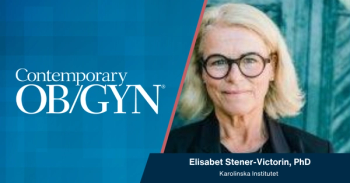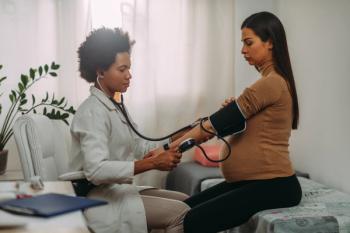
Taking Care of Adolescent Endometriosis Patients
OBGYN.net Conference CoverageFrom the 9th Annual Congress of the International Society for Gynecologic Endoscopy, Queensland, Australia, May, 2000
Dr. Hugo Verhoeven: “My name is Hugo Verhoeven, I’m a member of the Editorial Board of OBGYN.net, and I’m reporting from the 9th Annual Congress of the International Society for Gynecologic Endoscopy at Gold Coast in Queensland. I have the great honor talking at this moment with Deborah Busch who is a Chairperson of the New Zealand Endometriosis Foundation. Good morning, Deborah, and thank you for giving me the pleasure to talk to you."
Deborah Busch: “Good morning, Hugo, and I thank you very much for the opportunity to talk.”
Dr. Hugo Verhoeven: “You told me a few minutes ago that you are constructing in New Zealand something new, something sensational for our endometriosis patients that could be well an example for the rest of the world. Tell me about that.”
Deborah Busch: “Hugo, there are so many opportunities to improve overall health care for women with endometriosis. I’ve been working in the field as a founding member and Chair of the New Zealand Endometriosis Foundation, which is fifteen years old, and I realized a long time ago that we were ‘missing the bus’ in terms of establishing appropriate treatment pathways and managing disease effectively. We had some superb surgeons and some superb clinicians and consultants but we were pelvis driven. We know endometriosis is generally poorly diagnosed, poorly treated and poorly understood. We’re talking here about a multifactorial disease that needs to be treated in a multidisciplinary way, still utilizing an evidence based approach. I decided that further studies to prove the unacceptable levels of diagnostic delay could be counterproductive for us. The International statistics speak for themselves, and in fact, one of the things that needed to be done was to develop an adolescent educational program on menstrual health and endometriosis. Having a teaching background, I started working on the curriculum for that seven years ago; it’s been operational now in New Zealand for the last five years intermittently. Over 50,000 students have now participated in the program. While I haven’t had the funding to develop further research into exactly what that means for our young women, I can anecdotally say, that in the geographical regions where that education has taken place, we are addressing the issue of diagnostic delay. More young women are being referred to a gynecologist for investigation, more are being diagnosed and more are being treated earlier and appropriately. We hope to significantly reduce the costly downstream effects of this disease, to prevent disease progression, to alleviate suffering and the possible compromising of fertility. Girls are not necessarily aware that the symptoms they suffer may be a genuine problem. The program is highly interactive and it dovetails beautifully into the health curriculum in New Zealand. I have also developed the program so that it can be monitored and reassessed to mould into any adolescent program anywhere in the world because it’s a vitally important component in the treatment of endometriosis. Education is the key to early diagnosis and must be followed with the right treatment.”
Dr. Hugo Verhoeven: “You said 50,000 adolescents; I didn’t realize that New Zealand is that big that 50,000 adolescents have endometriosis. How do you try to have contact with them?”
Deborah Busch: “I’m sorry, the program has addressed over 50,000 young adolescent women and the evaluation has taken place over that many. It doesn’t mean to say that 50,000 youngsters have endometriosis. So internationally what is the prevalence rate? We don’t know in New Zealand, we do know that it’s a significant problem, and we do know that that problem needs to be addressed. It’s just one cog in the bigger wheel. As Chair of the Foundation for New Zealand I work very closely with gynecologists who are also sympathetic of the need to address these issues. Those gynecologists two of whom are on the Trust Board of the Foundation also are highly interested in making this program work because they understand the need. John Doig is the New Zealand Chair of RANZCOG - the Royal Australian New Zealand College of Obstetricians and Gynecologists, and Mark Insull in Auckland the Secretary Treasurer of RANZCOG. So by having some supportive gynecologists who understand the need is very beneficial. What isn’t helpful and a scandal, in fact, is the fact that the program is not funded by any pharmaceutical or surgical company who could really help to make a difference in this field. What I have to do, is go and seek sponsorship. I’ve just been granted sponsorship from a trading bank in Canterbury of New Zealand to rerun the program there for the third year. It really is phenomenal that money isn’t forthcoming to address the very issues that these companies want to address. This is an absolutely proactive area that we could make a difference together.”
Dr. Hugo Verhoeven: “So this is an appeal to the pharmaceutical companies who are making money with treatment of endometriosis to take care also a little bit of information of their future patients.”
Deborah Busch: “Absolutely, Hugo, and it’s not just of their future patients, it’s their patients now. We know out there that there are girls suffering who are not being treated. We must diagnose and treat disease in the mild or moderate stages before it becomes severe and requiring further more difficult and radical treatments. If interested and skilled gynecologists can use the surgical and pharmaceutical advancements and technologies before disease reaches that stage, doesn’t that make sense? Isn’t it basic? It sure is to me. If nothing else, it makes sense from a commercial view."
Dr. Hugo Verhoeven: “So let’s now go back to the beginning. How are you trying to have contact with your future patients? Do you have a web site available, are you going into the schools, are you informing just the doctors? Are you laying out in doctor’s offices some brochures informing patients about the eventual causes of their pain, that you say it could be endometriosis - ask your doctor or make contact with us and as soon as they contact you, what are you doing?”
Deborah Busch: “We’re doing a lot in that field, and of course, we were talking earlier weren’t we about cogs in the bigger wheel and, in fact, education is one aspect of how we can go about helping as well in New Zealand. We produce brochures, information, and our web site. We’re happy to help anybody who would like to get up and running with something similar. The education sits on the fringe of another very, very exciting venture and I am also coordinating a specialized endometriosis treatment center for New Zealand. Initially we plan one center, Hugo, and are going to look at the broader aspects of the disease endometriosis. For too long we’ve been ignoring women and their broader needs. There are now wonderful surgical procedures but we also need to involve the woman in the treatment loop. Isn’t this again basic because we’re not dealing with a quick fix condition. We’re dealing with a condition that is multifactorial and needs to be treated in a multidisciplinary way. So the centers we’re developing are multidisciplinary, and they’re patient focused. We’re just putting the finer details onto the whole aspect of the program and hope to be up and running around about July of this year.”
Dr. Hugo Verhoeven: “As soon as a patient knows that she has endometriosis, are you taking care of her also or do you say - listen, now you go to Doctor X and he will take care of you - are you still an extra support for those patients? That means the patients who have endometriosis, who had surgery, who are under medical treatment, can they still come to you and say - listen it’s all nice what the doctors are technically doing with me but I hate it, I don’t’ feel okay, I want psychological support and I need somebody who I can talk with. Is that also part of your job?”
Deborah Busch: “That is actually an inbuilt intrinsic part of the whole procedure, and in fact, I’m going ahead and developing the curriculum to develop the patient case manager or patient liaison/consultant role (or call it what you will). It’s a service which will provide information and support among other things. So the minute a woman is diagnosed - be they twelve years old, later teens or adult - their needs for their age at this particular time in their life are going to be met with more appropriate personalized individualized treatment pathways and sound follow up including establishing a database."
Dr. Hugo Verhoeven: “We talked until now just about what you’re doing today. You certainly have visions for the future or plans that you would like to realize as soon as possible, tell me about that.”
Deborah Busch: “Those plans are already in the making, Hugo, and exciting. At the moment we are limited in that we have two health systems operating in New Zealand, the private and the public, and so this system is going to be operating in the private system. Eventually, we want that to dovetail into the public system so that all women can access the kind of care that we are going to be promoting. I think a really exciting aspect of these treatment centers and the multidisciplinary team, is that we have on board and are encouraged by the largest healthcare insurer in New Zealand to be a part of the whole process. I approached Southern Cross Healthcare in New Zealand a year ago and they are now looking at saying how can we help, how can we be part of this. They understand with earlier diagnosis and covering the clinical and some of the multidisciplines, that, while a woman’s care initially might be more expensive, the long term downstream effects are going to be cost effective. They are now ready to sign off on the proposal. A woman wants to know that her other needs are being met, her psychological needs, her psychosocial needs, her individual needs, her education so that she can learn to manage it and therefore improve her quality of life. To have the largest healthcare insurer on board is just a very exciting aspect to all of this. It’s innovative and I think we’re doing it well in New Zealand. My vision for the future, is that the downstream effects flow on so that all women who suffer from this enigmatic and horrid disease can be diagnosed earlier and have better treatment pathways, and better access to those treatments in New Zealand and right around the world.”
Dr. Hugo Verhoeven: “Is there any chance that you will be able to realize that in the quite near future?”
Deborah Busch: “What an exciting thought. It’s exciting, Hugo, because this is one idea in New Zealand, and one idea that’s working. We all have ideas of how we can help and how we can make things better. If we can pool those ideas, if we can pool our resources, and work together to everyone’s advantage, that’s what this is about. If we can work together internationally to make a difference, then I’m very, very happy to work and coordinate a process to help it happen somewhere else.”
Dr. Hugo Verhoeven: “If it’s all right, we’ll publish you’re e-mail and address of your web site in this interview so that patients all over the world could contact you if they need some further information. Is that okay with you?”
Deborah Busch: “I’m more than happy with that, and I just think we are fortunate in having this kind of technology available to us now so that that makes these things sort of possible.”
Dr. Hugo Verhoeven: “Thank you very much”
Deborah Busch: “Thank you very much, Hugo.”
Newsletter
Get the latest clinical updates, case studies, and expert commentary in obstetric and gynecologic care. Sign up now to stay informed.
















